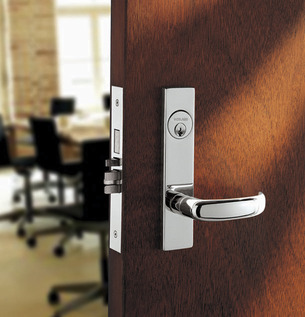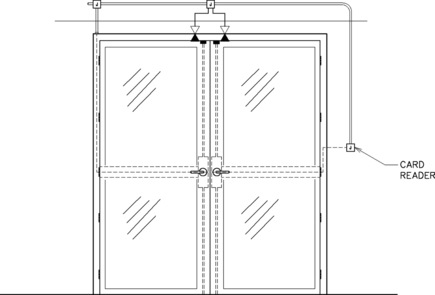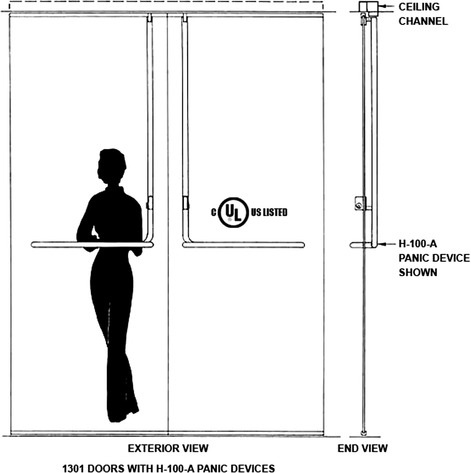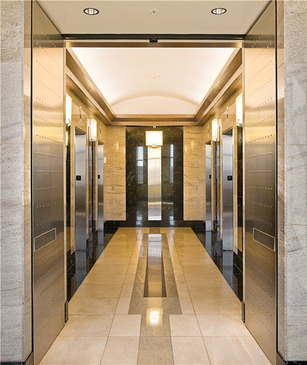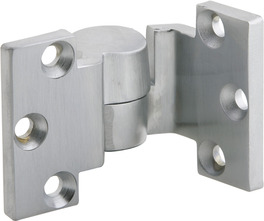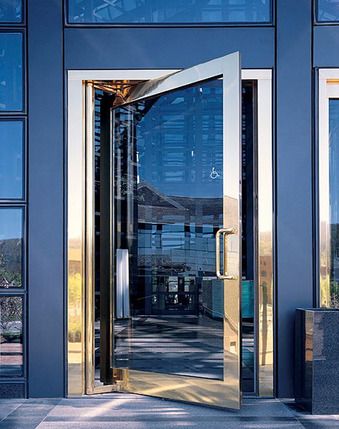7. Door Types and Door Frames
Chapter objectives
1. Discover the Basics about Doors and Security
2. Understand the Basic Single-Leaf Door
• Hollow Metal
• Wood
• Framed Glass
• Unframed Glass
3. Understand Double-Leaf Doors
4. Learn All about Door Frames
• Hollow Metal
• Aluminum
• Wood
5. Get a Line on Roll-up Doors
6. Understand All about Revolving Doors
7. Pass a Quiz on Door Types and Door Frames
CHAPTER OVERVIEW
This chapter expands on the information contained inChapter 5. Access Control is all about controlling access through portals. For pedestrians, most portals are at a door and door frame.
This chapter explains the basics you need to know about how doors and frames are constructed and how they affect access control portal decisions.
This chapter expands on the information contained in Chapter 5, Access Control Portals. Access Control is all about controlling access through portals. For pedestrians, most portals are at a door and door frame.
This chapter explains the basics you need to know about how doors and frames are constructed and how they affect access control portal decisions.
Keywords: Access Control, Control, Door, Frame, Pedestrian, Portal
Author Information:
Thomas L. Norman, CPP, PSP, CSC, Executive Vice President, Protection Partners International
Basics about Doors and Security
My first job as a Security Consultant was in Southern California working for one of the top Security Consultants in the nation. I am very grateful for all he taught me. He was a brilliant man who could win an argument on any subject. People knew this and so out of great respect often they did not invite him to parties. 1 Once, however, he stated that electronic security was far more important than physical security. Ah ha! I jumped on that immediately.
I asked him to imagine an empty field of grass. Now, I said, imagine a steel structure made of columns and beams in the field in the shape of a single story building. Now please place an entire security system including card readers, door position switches, locks, exit sensors, motion detectors, and video cameras all mounted to the columns and beams. Now, please imagine wiring all of these system elements to a desk in the middle of this structure with a computer and monitors to monitor the conditions in the security system. Got it? OK? What do you have? You have a working security system and no security whatsoever. Security begins with physical security. There is no security without physical security. He conceded the argument. (The only time that ever happened, so the moment is hard to forget.)
Electronic security supplements physical security. To secure physical assets, one must have a container to which one can control access to authorized people and restrict access from unauthorized people. The original and continuing reasons people chose to live in caves and later in structures are to provide shelter from weather and to protect themselves from wild beasts and plundering tribes. But if buildings secure assets, one must provide a way to get into and out of these protective structures. And so was created the door.
Doors have a tough job. A door can be evaluated on a number of important criteria:
• They must block passage
• They must open and close easily
• They should be robust against intrusion
• They should fit the visual aesthetics of the environment in which they are mounted
For access control applications, physical security is usually a given. Except for the rare total glass lobby doors, doors used in access control applications should be robust and able to withstand at least a moderate physical attack.
But a door is just a panel in a wall hung from a frame. So the frame is also an important part of the security package. A robust door hung in a light wood frame will be of little use in securing what is inside. We will evaluate doors and frames in this chapter to review their capabilities and limitations.
Standard Single-Leaf and Double-Leaf Swinging Doors
The basic door is the standard Single- and Double-Leaf Swinging Door. This door includes a frame, hinges, door(s), a lock, and sometimes other hardware including a door closer, door coordinator (closes one door, and then the other), and kick plates. Swinging doors are available in a wide variety of types of construction including:
• Hollow Metal Doors
• Solid Core Wood Doors
• Framed Glass Doors
• Unframed Glass Doors
• Total Doors
This list excludes doors not common to commercial environments. Let's look at each type of door:
Hollow Metal Doors
Hollow Metal (Figure 7.1) Doors are the workhorse of security. The basic Hollow Metal Door includes an internal metal frame and metal skin. There are usually cutouts on the frame for hinges and for a lock. The three most common types of access controlled locks on Hollow Metal Doors are mortise, electrified panic hardware, and magnetic locks. Hollow Metal Doors are fitted from the manufacturer for the type of lock they are to receive. Doors that receive mortise locks are pre-fitted with a mortise pocket, whereas a door that is to be fitted with electrified panic hardware may receive either concealed or surface-mounted vertical rods.
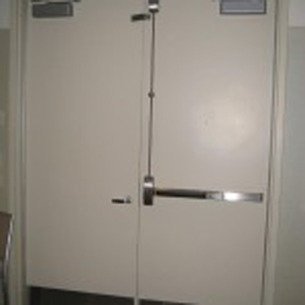 |
| Figure 7.1 |
Assets: Hollow Metal Doors are robust—some more than others—and are available in a variety of security (penetration test) ratings and even in blast- and bullet-resistant versions. They also score very high on fire resistance and are available in UL listed fire ratings up to 2 hours (including the frame).
Liabilities: Hollow Metal Doors in their basic form are not pretty; however, they can be laminated with appearance coverings that emulate fine woods or other finishes.
Caveat: Hollow Metal Doors can be mounted to hollow metal, aluminum, or wood frames; they are only as secure as the frame they are mounted to.
Suitable hardware: Hollow Metal Doors can be equipped with electrified mortise locks, electrified panic hardware (with surface-mounted vertical rods), and magnetic locks. These doors can be cored to run the lock power to a mortise lock from the hinge using an electrified hinge that has wires running through it from the frame to the door. This allows for invisible wiring to the mortise lock. Power can be run to electrified panic hardware using either a flexible or coiled cable, flexible conduit, or through an electrified hinge sleeve.
Solid Core Wood Doors
Solid Core Doors (Figure 7.2) are primarily used in finished office spaces because of their superior appearance. They are manufactured using a wooden frame. Unlike hollow core Wood Doors, which use a honeycomb of cardboard as an insert into the frame, Solid Core doors use an engineered wood filler, fully filling the wood frame inside. The door is then provided with a basic wood veneer skin and then with a fine wood or plastic veneer. A router is used to create hinge insert locations and a mortise pocket if appropriate. Then a hole is drilled for the door handle. Solid core doors are available with UL-listed fire ratings up to 90 minutes.
Assets: Solid core doors are beautiful and can be somewhat less expensive than a Hollow Metal Door.
Liabilities: Solid core doors are robust, but not as robust as a similar Hollow Metal Door. They are more susceptible to flexing if torqued (say, by a fool who holds the door open by placing an object between the door and frame at the hinge area) and can be susceptible to mis-fittings due to building settling, although this is usually because many solid core doors are fitted into aluminum frames, which are more susceptible to this.
Suitable hardware: Solid core doors can be equipped with electrified mortise locks, electrified panic hardware (with surface-mounted vertical rods), and magnetic locks. These doors can be cored to run the lock power to a mortise lock from the hinge using an electrified hinge that has wires running through it from the frame to the door. This allows for invisible wiring to the mortise lock. Power can be run to electrified panic hardware using either a flexible or coiled cable. These doors are not suitable for an electrified hinge sleeve.
Framed Glass Doors
Framed Glass Doors (Figure 7.3), also called “Storefront Doors,” are found on the front doors of merchant stores and small office buildings. Framed glass doors are manufactured using an aluminum frame with a tempered glass insert. Typically the glass is a single pane, completely filling the frame, but you will occasionally see frames that have upper and lower glass inserts, allowing for a space to mount a mortise lock or electrified panic hardware.
Framed glass doors should not be considered security doors as it is possible to easily break the glass and enter the area with simple tools (or even a well-placed kick).
Assets: Framed Glass Doors provide a view into and out of the secured space. They are the least expensive type of glass door.
Liabilities: A well-placed kick can get an intruder inside the space. Framed Glass Doors carry no fire rating. They should be considered a psychological, rather than a physical, barrier.
Suitable Hardware: Framed Glass Doors typically use either electrified panic hardware with surface-mounted vertical rods or magnetic locks. A few Framed Glass Doors that have a middle aluminum section can also be fitted with a mortise lock, but these are rare.
Unframed Glass Doors
Class A Office Buildings often use Unframed Glass Doors (Figure 7.4) as the centerpiece of their main lobby entry. Frameless Glass Doors are made by creating a thick glass plate, typically between ½" to ¾" thick, depending on the size, which is usually hung into a frameless glass frame (a series of glass panels to the sides and above the doors). It is not unusual to see a large beam above the doors supporting the top pivots.
Assets: The key asset of Unframed Glass Doors is their appearance. The look of an uninterrupted sheet of glass on the front of an iconic building is architecturally spectacular.
Liabilities: Unframed Glass Doors are strong due to their thickness, but there have been cases when they have been tweaked by an aggressive person pulling hard against a locked door and the door has broken; shattered actually into thousands of small glass pebbles because they are made of tempered glass. It is spectacular when it happens. Due to their ability to break, Unframed Glass Doors should not be considered security doors as they present a psychological, rather than physical, barrier.
Most Suitable Hardware: Except for the smallest examples of Unframed Glass Doors, which you will occasionally see on the front of a small office suite, Unframed Glass Doors are mounted using Pivots instead of Hinges. Because they are completely glass with no structure to mount a lock to, Unframed Glass Doors cannot mount a mortise lock or conventional electrified panic hardware (although on one occasion I saw an awkward example of such). The most common electrified lock on Frameless Glass Doors is the magnetic lock.
Total Doors
Total Doors are a real “find.” These doors solve an amazing array of architectural and security problems, so it is surprising that many architects do not know about them (Figure 7.5). Total Door® is the name of a firm that makes a complete integrated door including doors, frame, continuous hinge, and integral locking hardware.
Assets: This door is amazing. It is suspended by a long wire hook from an area near the top of the frame (hinge side) to an area near the bottom of the door, similar to a long wire coat-hanger type of hook. That wire supports the entire weight of the door. The door swings on a full-height, semi-concealed hinge that fits flat and can rotate up to 180 degrees, folding the door flat into a pocket against the wall. The hinge takes up less space than a conventional door so there is greater clear width. The lock is equally unique. It comprises a full-height locking channel that cocks at an angle when open and snaps shut over the full length latch stop when closed. It provides exceptional security on single doors and eliminates vertical rods, floor hardware, coordinators, astragals, and flush bolts on pairs and double-egress doors (where each door of a pair swings in an opposite direction — very common in hospitals). The lock can be equipped with a flush mounted panic fire exit device that does not extend into the door opening when open, fitting flush into the door. The doors are also very robust and forgiving of frame alignment issues. Total Doors are available in a variety of fire/smoke ratings depending on the materials used in A Label (up to 3 hours), B Label (1-1/2 hours), and C Label (90 minutes). Total Doors are also available in a hurricane-rated door system in both in- and out-swinging versions. OK, I admit it; I like these doors.
Liabilities: Total Doors are more expensive than conventional doors.
Suitable Hardware: All hardware is part of the Total Door assembly, not added on like conventional doors.
Pivoting Doors
Pivoting Doors (Figure 7.6) are highly unusual in the United States; they are more common in Europe, Asia, and the Middle East. A pivoting door is a double width door that swings from the middle, not from the side. When a pivot door opens, both sides open — one side in and the other side out. Pivot doors are almost always used on the front of boutique shops. Pivot doors are typically of Framed Glass door construction.
Assets: They are unique architecturally, so they provide an interesting feature to the space they enclose.
Liabilities: Pivoting Doors can surprise people nearby as the door swings inward as a person walks out.
Suitable Hardware: These doors are typically not locked with electrified hardware, but when they are, it is usually with magnetic locks.
Balanced Doors
Balanced Doors (Figure 7.7) were invented by Ellison Bronze in 1927. They are architecturally interesting doors that are hinged using an articulated hinge such that the door requires much less force to open than a normal door of its weight. The weight of the door is carried on a pair of balancing beams (one at the top and one at the bottom) such that when the door opens, about two-thirds of the door swings outward while one-third of the door near the frame swings into the space as a person opens the door outward. The door travels in an elliptical arc rather than the circular path of most doors. This allows external wind loads to assist rather than resist the opening of the door.
Assets: Using the balancing mechanism, very heavy doors can be used that a normal person would have great difficulty opening. It is possible to open these doors literally with fingertip operation, which can eliminate the need for power-assisted openers. So these doors are sometimes balancing monumental doors. Balanced doors are used almost entirely on the front of Class A office buildings.
Liabilities: Because a portion of the door near the hinge swings inward when the door swings out, it is possible for someone to catch their hand in the space between the door and the frame so that as the door closes again it closes on the person's hand, possibly breaking bones. Sensing hardware is available to stop the door from closing on fingers.
Suitable Hardware: Balanced Doors usually use magnetic locks.
Door Frames and Mountings
Once we understand the types of doors available, it is important to understand the different types of door frames and mountings. Door frames are rated by frequency of use and ability to withstand impact.
Hollow Metal — High-Use and High-Impact
Hollow metal frames are the most common type of door frame in commercial buildings. Hollow metal frames are robust and suitable for frequent use and environments where doors receive abuse by impact from carts and so forth. Rooms such as those at building perimeters, delivery and service doors, toilets, classrooms, and office suite doors are high-use rooms and are suitable for hollow metal frames. These frames are structurally sound and are not prone to flexing with minor building settling as much as aluminum frames, thus, the doors stay aligned longer than lesser frames.
Hollow metal frames are commonly built with ANSI mounting areas for hinges, frames, and door strikes. The doors can also be fitted with integral electrical enclosures for electric strikes, locks, door position switches, and electrified hinges.
These frames can be configured for single or double openings, either in the same or opposite directions (double swing door — one in/one out) with features for sound control, ballistic resistance, and fire and smoke penetration resistance. They can be configured to accept from two to many hinges or a continuous hinge.
Hollow metal frames/doors can carry fire penetration ratings from 90 minutes up to 3 hours. They are suitable for Hollow Metal Doors, Solid Core Wood Doors, or framed glass doors.
Aluminum — Medium-Use and Medium-Impact
Aluminum frames are suitable for moderate use and impact. These frames are less expensive and lighter weight. They are typically used in medium-use and medium-impact applications, such as on an office suite.
Aluminum frames can carry fire penetration ratings for 20, 45, or 60 minutes. Aluminum frames are suitable for Solid Core Wood Doors or framed glass doors.
Wood — Light-Use and light-Impact
Wood frames are not normally used in modern commercial applications, but they are sometimes seen on older and historic buildings. They are strictly for light duty and light impact. They are not normally fire rated.
Door Mounting Methods
Doors are normally mounted to frames using individual or continuous hinges, but they can also be mounted using Pivots or a Balanced Door mechanism. Hinges are inexpensive and easy to apply (many installers know how to mount doors using hinges). Continuous hinges are rarer but are extremely robust since the door cannot easily be torqued in the frame. Pivots and Balanced Door mechanisms are typically used to mount framed glass or monumental doors.
Overhead Doors
Roll-up Doors
Roll-up Doors are common in vehicle and freight entries and are rarely used in industrial door openings for pedestrian doors. Roll-up Doors are mounted into a pair of “C” channels to the left and right of the door opening and a spring-loaded roller mechanism receives the roll-up elements at the top of the door.
Roll-up Doors are suitable for moderate security, but can be cut open with a high-speed rotary saw.
Paneled Overhead Doors
Paneled Overhead Doors (Overhead Garage Doors) are comprised of a single or double panel that folds up into the space above the door opening. Double-Leaf overhead doors simply fold the two leaves flat against each other at the top of the opening. These doors are relatively easy to break into using simple tools.
Revolving Doors
Revolving doors consist of three or four leaves (or wings) centered on a central pivoting shaft that has a vertical axis. These are enclosed in a round enclosure with openings on the inside and outside to allow passage as the door rotates within the enclosure. Revolving doors may be manually or automatically operated. Large diameter revolving doors can accommodate rolling luggage.
Revolving doors provide a draft block for high-rise buildings that prevents the chimney effect that would otherwise allow the air to circulate from bottom to top of building, creating energy costs for heating and air conditioning.
Revolving doors can be equipped for special functions such as one-way passage to prevent a person from bypassing airport security checkpoints. Those doors use a braking mechanism to prevent opposite flow, then the door automatically revolves backwards to allow the offender to exit from the entry side.
A version of revolving doors is used in factory and subway environments where the leaves of the door are made from horizontal pipes that interleave with a barrier to allow entry in only one direction. These doors ratchet to prevent reverse direction traffic.
In 1942 at a popular nightclub called the Cocoanut Grove in Boston, Massachusetts, a fire broke out killing nearly 500 people. This happened because there was only one revolving door at the front to allow passage and people became jammed into the opening with many dying of smoke inhalation. Since then a change in the fire code has required flanking outward swinging doors or a mechanism that makes the revolving door leaves collapsible, allowing people to pass on either side. All American revolving doors are now collapsible and most jurisdictions also require flanking panel doors.
Revolving doors can be equipped with magnetic locks for access control.
Sliding Panel Doors
Sliding Doors simply slide rather than swing to create an opening. Sliding Panel Doors comprise a Single- or Double-Leaf setup that slides along a track to open and close. Sliding panel doors are used in industrial and office environments (usually where there is a high passage count). Sliding doors may be manually operated (usually in industrial environments) or automated (usually in office environments). Automated sliding doors may be Single- or Double-Leaf (think grocery store front door).
Automated sliding doors can be easily interfaced to access control systems. The interface comprises tying the door lock relay of the Access Control Panel to the trigger input of the automatic door operator.
Bi-Fold and 4-Fold Doors
Bi- and 4-fold Doors are also used both for industrial and office environments. Bi-fold Doors comprise two leaves that fold together and 4-fold Doors comprise two sets of Bi-fold Doors. These are almost always automated in both applications. Both can be interfaced to access control systems in the manner described in the section Sliding Panel Doors.
Chapter Summary
1. Electronic Security supplements Physical Security.
2. Standard Single- and Double-Leaf Swinging Doors include:
• Hollow Metal Doors
• Solid Core Wood Doors
• Framed Glass Doors
• Unframed Glass Doors
• Total Doors®
• Pivoting Doors
• Balanced Doors
3. Standard Door Frames and Mountings include:
• Hollow Metal — High-Use and High-Impact
• Aluminum — Medium-Use and Medium-Impact
• Wood — Light-Use and Light-Impact
4. Doors may be mounted using:
• Standard Individual Hinges
• Continuous Hinges
• Pivots
• Balanced Door Mechanisms
5. Overhead Door types include:
• Roll-up Doors
• Paneled Overhead Doors
6. Revolving doors consist of three or four leaves (or wings) centered on a central pivoting shaft that has a vertical axis. These are enclosed in a round enclosure with openings on the inside and outside to allow passage as the door rotates within the enclosure. Revolving doors may be manually or automatically operated. Large diameter revolving doors can accommodate rolling luggage.
7. Sliding Panel Doors comprise a Single- or Double-Leaf setup that slides along a track to open and close.
8. Bi-fold and 4-fold Doors comprise two leaves that fold together, and 4-fold Doors comprise two sets of Bi-fold Doors. These are almost always automated in both applications.
1) What is the basis of security?
a. Physical Security
b. Electronic Security
c. Both Physical and Electronic Security
d. Neither Physical nor Electronic Security
2) What are the two kinds of pedestrian doors?
a. Single-leaf and Double-leaf doors
b. Hollow Metal Doors and Solid Core doors
c. Framed Glass and Unframed Glass doors
d. Hollow Metal and Total Doors
3) What common kind of door is the most secure?
a. Solid Core Wood doors
b. Hollow Metal Doors
c. Framed Glass doors
d. Unframed Glass doors
4) Pivot Doors are typically of what kind of construction?
a. Hollow Metal
b. Solid Core
c. Framed Glass
d. Unframed Glass
5) Balanced Doors are mounted using
a. Common hinges
b. Continuous hinges
c. Articulated hinges
d. Pivots
6) Which kind of frames are the most secure?
a. Aluminum
b. Wood
c. Hollow Metal
d. None of the above
7) Hollow Metal Door Frames are for
a. High Use and Medium Impact
b. Medium Use and Medium Impact
c. Low Use and Medium Impact
d. High Use and High Impact
8) Aluminum Door Frames are for
a. Low Use and Medium Impact
b. Medium Use and Medium Impact
c. Low Use and Low Impact
d. High Use and High Impact
9) Wood Door Frames are for
a. Low Use and Medium Impact
b. Medium Use and Medium Impact
c. Low Use and Low Impact
d. High Use and High Impact
10) Overhead Doors include:
a. Hollow Metal and Solid Core
b. Hollow Metal and Roll-up
c. Paneled and Solid Core
d. Roll-up and Paneled
11) Revolving Doors
a. Comprise three or four leaves around a central horizontal axis
b. Comprise three or four leaves around a central vertical axis
c. Can be equipped with magnetic locks for access control
d. Both b and c
12) Sliding Panel Doors
a. Are made of one or two panels
b. Can be automated and operated by an access control system
c. Both a and b
d. Neither a nor b
13) 4-fold Doors
a. Comprise four sets of individually operating panels
b. Comprise two sets of bi-fold doors
c. Neither a nor b
d. Both a and b
Answers: 1) a, 2) a, 3) b, 4) c, 5) c, 6) c, 7) d, 8) b, 9) c, 10) d, 11) d, 12) c, 13) b
..................Content has been hidden....................
You can't read the all page of ebook, please click here login for view all page.

